One of the most popular Spanish traditions is the ” Los Reyes”.
“Los Reyes” one of the many Spanish traditions.
In Spain, January the 6 is the equivalent of our Christmas and Saint Nicolas.
On the night before, the 5th of January most Spanish tons and city’s have their parades of the ” Los Reyes”.
This parades marks the arrival of the very popular kings. This three kings are Melchior, Balthazar and Caspar. Every where there are processions and parades in the main streets with sweets or ” dulces” thrown to the children. For the children is is a magic night.
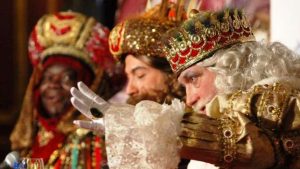
After the parade the children and their parents go home. They place their shoes nearby the windows.
They fill the shoes full with straw and carrots for the donkeys. Like our children do with Santa Claus .
The morning after, the 6 January, the children receive their presents from the Three Kings. At least , when they are good children.
When they have been bad: a sack of coal.
It is the day of ” Los Reyes “. It is an official day of. The large Spanish family are coming together. The eat lamb and final a ” Roscon de Reyes”. This cake is a round crown, full of dried fruit and nuts.Inside the crown , the pastry there is a little hidden gift. Indeed a little lucky charm.
The one has the hidden gift in his / her portion will have good luck not for one day but the entire year.
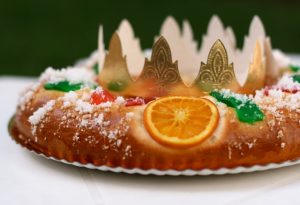
Also chocolate and ” turron” are very popular.
See also our page gastronomy at Costa Blanca
The day after the Three Kings starts the sales in Spain. The Spaniards call them” Rebajas”.
Many shops have already reduction on their stocks the days before. Buy two, get one free.
Turron a very sweet Spanish traditions.
Turron is the most popular Christmas and New year treat.
It has been popular for ages.
During the month of december, it is sold nearly everywhere in the shops across Spain.
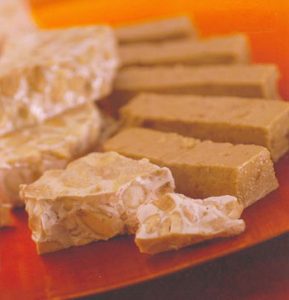
It is also a treat on the evening of “Los Reyes”, the 5th of January.
There are two sorts of Turron.
Read more on our page Turron from the Alicante regio
Grapes on New year eve another Spanish traditions.
Another Spanish tradition on new year Eve are the grapes. The grapes are sold every where at the supermarket the market. In nice bags , in tins. Some are peeled, other natural
At the strike of the clock of midnight, you have to eat one of the grapes.
In fact, by the time the clock finished his 12 stroke you have eaten all 12 of them.
We can assure you , it is not so easy. So if you do, you will have luck for the following 12 months . Indeed 12 grapes, one for each month. But sweet grapes are a sign for a good month , sour grapes a sign for a not so good month.
We think that very few manage to eat them all. Our mouth was really full. And we did try to swallow them all.
In the past, this Spanish tradition starts by the vine growers in the Alicante province.
Besides, many towns and city’s have a party on the beach with firework.
In short, there is a great atmosphere, with many bottles of cava to celebrate the New Year.
Fire work is believed to scare away evil spirits.
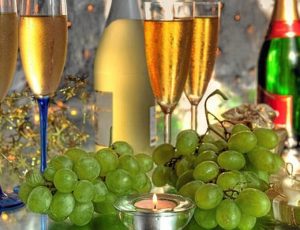
Another Spanish tradition : Semana Santa.
Spain is very famous for the events and the processions held during the Holy week or Semana Santa. This Holy week is the week before Easter .
Spanish people are very religious.
The Semana Santa includes the Palm Sunday , the Holy Thursday and Good Friday.
Many shops are even closed.
It does snot include the Easter Sunday.
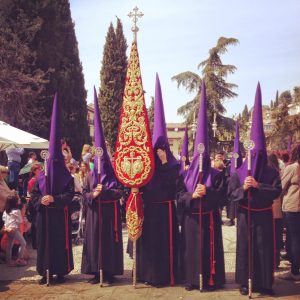
In fact, the processions in the Spanish city’s and towns are very spectacular.
Some people are even afraid, because the participants of the procession wear the famous ” nazareno” of the penitential robe. This tunic has a conical-shaped hood. This hood is used to hide the face of the person who is wearing the ” nazareno “. Sometimes the walk barefoot as a form of penance .
The origin of the robe is medieval.
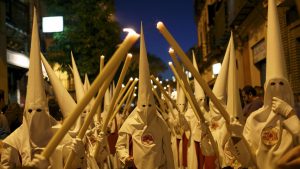
In the procession, beside the “nazarenos” some wear the uniform similar to those of the soldiers of the Roman period.
The Spanish traditions of the Semana Santa have history of over 500 years.
Throughout Spain, holy processions are organized.
Typical are also the “trono” or a sort off platform with many religious ornaments.
This “trono ” is full with sculptures with scenes from the Passion. The Passion in the Holy week is the suffering of Christ before and during his Crucifixion.
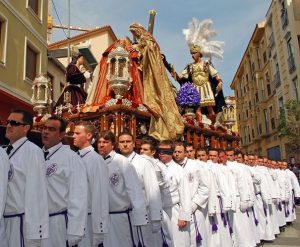
The procession is accompanied by music ” the seata”. It is a very old Spanish tradition, religious song.
In sum , seeing a procession in the Holy week is a very spectacular events for the visitors.
Feria de Abril
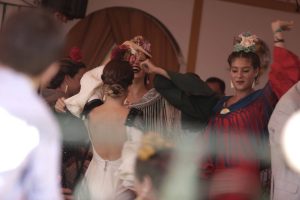
Two weeks later, after Semana Santa or Holy week , it is the Feria de Abril. A week of party and parades.
In the past , it starts in Andalusia and Sevilla.
Now, the Feria the Abril come more and more popular in the other parts of Southern Spain.
People in Andalusia like a good party.
In Sevilla the Feria de Abril had grown into the city’s largest annual fiesta. People from over the world come to see the beautiful costumes at the April Fair .
There are all sort of attractions. There is a fairground, singers , dancers, typical rides with horses.
Sevillas
Women and men are beautiful dressed. The women wear their beautiful flamenco dresses. And the men their traditional suits. The woman really look spectacular in their traditional sevillanas dress.
They not only look superb, they dance also superb “the sevillanas” , the famous Flamenco dancing.
The birthplace of Flamenco is in Andalusia , more specific in Sevilla.
In the past, the colorful dresses of the women were known as gypsies dresses.
There are performances by different dance academy and ballet group specialist in Flamenco.
In the evening you can participate at several concerts by Flamenco singers.
There are also horseback parades. It is really worth to see the procession with the beautiful horses and the colorful dresses. Horses and Carriages pass trough the fair.
Casetas or bars
During this week , the participants have to eat and drink to ! Most of the bars ” casetas” are fully equipped with kitchen, bar and a music system. So that is the place to be for typical Spanish cuisine : tapa tasting . But some of them are private. Indeed, only for friends and family of the owner.
Otherwise, there are many public casetas also.
In the morning, you can tasting another specialty : the Churros and the chocolate in the many little bars.
Of course there is also a floral offering to the local Virgin.That is the moment of a procession from the fairground to place of “Nuestra Senora del Virgin” at the local church. This procession, is with the participation of local brotherhoods and horses and carriages.
At the end of the Feria the Abril , there is mostly a spectacular fire work.
The first time we visited a Feria de Abril forty years ago, it was sensational. And it still is.
When you are at the South of the Costa Blanca, it is worth a visit when you like to party, to eat and to drink. Who not ?